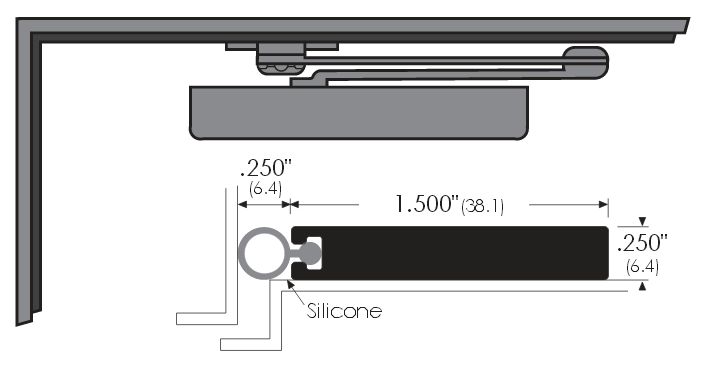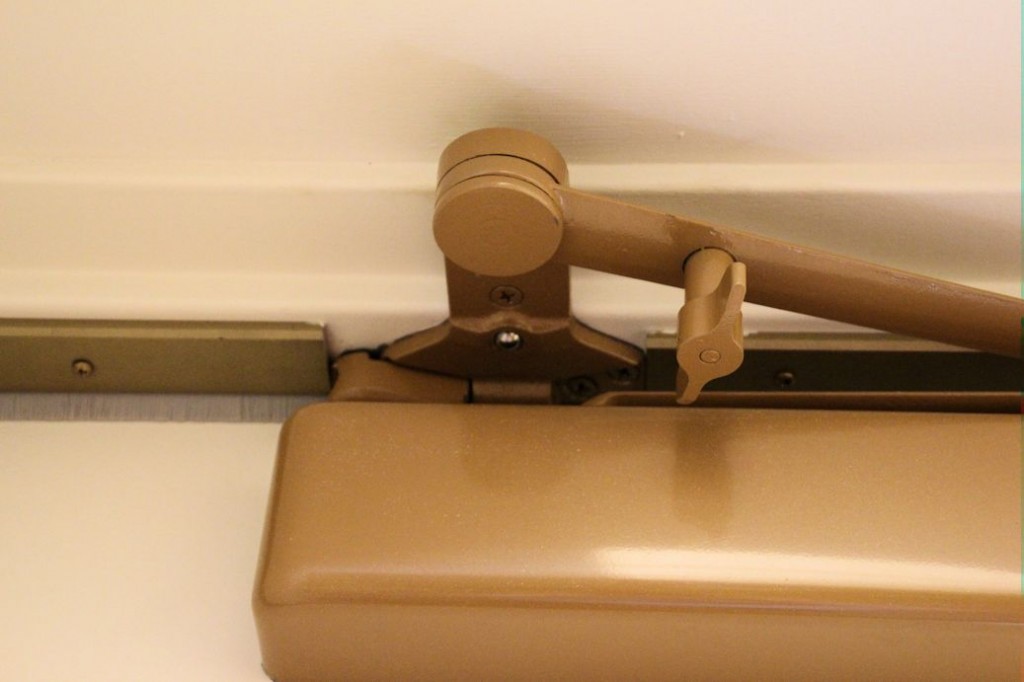
After 7 years of posting a new piece of door & hardware information on this blog every day, it makes me very happy to receive a new question that I haven’t thought about before. Last week’s question was related to the solid bar gasketing designed to allow closer shoes (and other hardware) to be attached directly to the gasketing, rather than discontinuing the gasketing in the location of the closer shoe. I have specified this type of product on many projects and it always makes me crazy to see that instead of installing the gasketing first and attaching the closer to the gasketing, the closer was installed first and the gasketing cut around the closer shoe (see photo below).
So the question is…can door closers, coordinators, and strikes for surface vertical rod exit devices be mounted to the gasketing – if the door is a fire door? Something this specific would not typically be addressed in the codes or standards (at least – it isn’t addressed today), so I checked with our compliance engineers who are responsible for all of our certifications and listing procedures. Our opinion is that a closer shoe or coordinator could be mounted to the gasketing*, because even if the aluminum melts away during a fire, the closers/coordinators have already done their job before that occurs. BUT – the strikes for the fire exit hardware must be attached directly to the frame with the gasketing discontinued at the location of the strikes, because the latching hardware must keep the door closed and latched for the duration of the fire.
Does anyone have different thoughts/opinions/experiences with this application?
*Note: In order for gasketing to be used on a fire door assembly, it must be listed for that purpose.
~~~
This is an exterior door where the gasketing was intended to be installed first and the closer mounted to the gasketing. Foiled again. Here’s another post where I saw a similar gasketing situation, except not with the solid type.
You need to login or register to bookmark/favorite this content.






The applied gasketing is a nice item for the gasketing manufacturers, but it can be a real pain to detail and coordinate… we have to have prep codes noted to adjust back set by an additional ¼” when rim panics are used on single doors and since we pre-install hardware on most projects, we need additional notes for our installers to allow for the gasketing when mounting parallel arm door closers. We also add notes in the schedule sets for the contractor to install the gasketing first, but it might as well be written with disappearing ink because it usually doesn’t happen!
I had this type of gasketing on a project with FEMA 361 rated metal doors and FEMA 361 rated surface vertical rod panics and we instructed the contractor to cut the gasketing around the strikes because the strikes, in this case, must be applied directly to the frame.
Give me a roll of good old peel & stick!
I have always installed the solid bar gasketing all the way around making it uniform then installing all applicable hardware on top of it. I substitute longer rated (steel/stainless)(higher grade) fasteners to comply with fire codes and provides a better seal around door.
In ur color photo, the weatherstripping would interfere with the spring stop arm function if installed that way.
Maybe I’m not understanding something here.
So if the closer shoe gets mounted to the soft aluminum gasketing, would the shoe not be securely mounted to the frame causing the shoe to rock during use and get loose? I can see the gasketing get crushed over time, loosening the shoe. Do I shim the thickness of the gasketing to have a solid shoe mounting?
I haven’t seen a problem with the shoe rocking, but maybe someone else will weigh in on this. You should not have to use a shim if the gasket is wide enough, but you may still need the 5th screw spacer for certain closers.
– Lori
I personally think that with the improvements made to adhesive mounted gaskets, they make a much better application. Coordination is difficult. Think about the solid bar gasket, bar type coordinator and a PA arm closer, OH my goodness.
I spent 10 years as an installer before I came into sales and project management and can tell you first hand that this is mostly cause by laziness. The exterior doors are always installed first and generally before the project is ready for doors or hardware. So the doors get hung and the closer is installed to protect them during construction and a temp hasp such as the Don-jo TL1/2 is used to secure the door. When the job is ready for the finish hardware, the installer comes to this opening and in order do it correctly, the closer must be removed and lowered to accommodate the weather stripping and that is just too much to ask of the installers. Most of the installers in this area are piece work subs and only get paid to do it once. On the other hand if the weather stripping is installed too soon, it gets damaged and has to be replaced.
The closer shoe will be just as secure as if you were installing it on a frame with a narrow stop. On most newer weather stripping, the aluminum retainer is made to support itself and not crush. The bulb is Kerfed into the retainer so that should not be an issue. The fifth screw should always be used on and stop arm closer.
My question is… Who uses brush weatherstripping at the head and jambs of a frame as shown in this picture??
When I was a rep for NGP, I was taught that the nylon brush gasketing was the most forgiving, the most likely material to seal properly against the door, so that’s what I specified for years. I’ve recently heard that some people prefer silicone for perimeter gasketing. What do you prefer?
– Lori
Modern adhesive-applied gaskets applied to the reveal of the frame are much more efficient as well as less expensive than compression type screw-on gaskets. The expensive aluminum is used simply to house the relatively inexpensive resilient material. Early adhesives were unreliable and do not age well or store well, while at least one manufacturer, DHSI, can warrant their modern adhesive for the life of the installation (I’m unaware of any other mfrs). Aluminum was used because there just wasn’t another way to get the resilient material in place, and so the seal was necessarily a jamb-applied compression type rather than the reveal-mounted “wipe” type application.
All that to say that the bar type gasketting is a dumb, expensive, problematic way to seal a door, and unreliable over time when the door warps / bows / sags and the resilient material’s contact with the door face is broken, or the resilient material is abraded and torn. Reveal-applied has its challenges, too, though: the door clearances need to be well-fitted within the frame, or you can get undue squibbing of the seal against the door edge. Once installed, though, reveal-located seal is more efficient and longer-lived than the outdated screw-on types.
Do you feel that the adhesive gasketing is sufficient for climates with below-zero temps and blowing snow?
BTW – You didn’t just call me dumb, right? 🙂
XO
– Lori
LOL! Lori, you’re one of the smartest people I know! I’m thinking like a SoCal guy, and you’re right, the adhesive-applied type alone is gonna be insufficient for harsher climes’ exterior doors, in which case I’d supplement with an adjustable or self-adjusting jamb-applied seal.
I usually in my area the general contractors only want the door hanging and closer installed to prevent damage. The frame usually not been painted. The bar type make a cleaner job than cutting around it, but make sure your installer is made aware the closer will need dropped the thickness bar. And then there arm some closers where the screws will not be long to work with bar
The first problem with screw applied jamb seal is that the seal itself is small and has limited sealing range. If the seals are adjusted too tight to the door, then the door will not latch. If adjusted to press lightly onto the door, then the door will pull away from them when it experiences thermal bow due to different temperatures on the inside and outside faces. Worse case scenario is black painted HM doors which bow up to a 1/4″ in full sun.
The second problem is that the screw on stop seal is used mostly on exterior frames but many of these are thermally broken now. Pretty sure all those screws that hold on the stop seal are either creating a thermal bridge that shorts out the insulator between inside and outside frame sections, or they are causing the two parts of the frame to separate.
I have used S773 in the past to correct sealing issues at dark painted exterior doors where the screw on jamb seal was not up to the task.